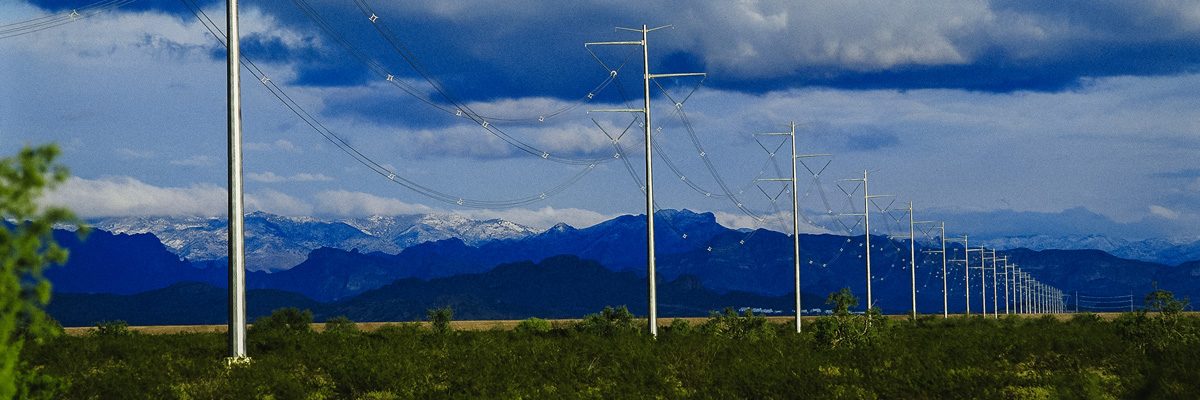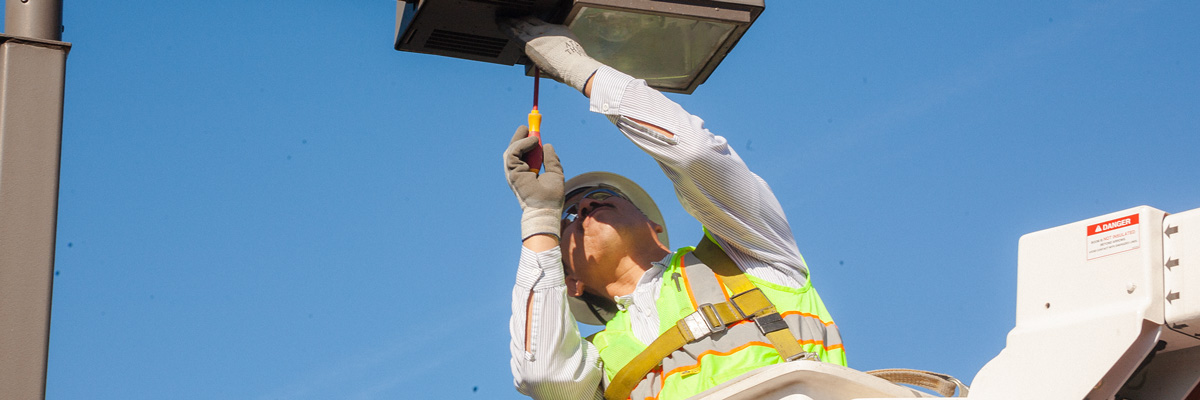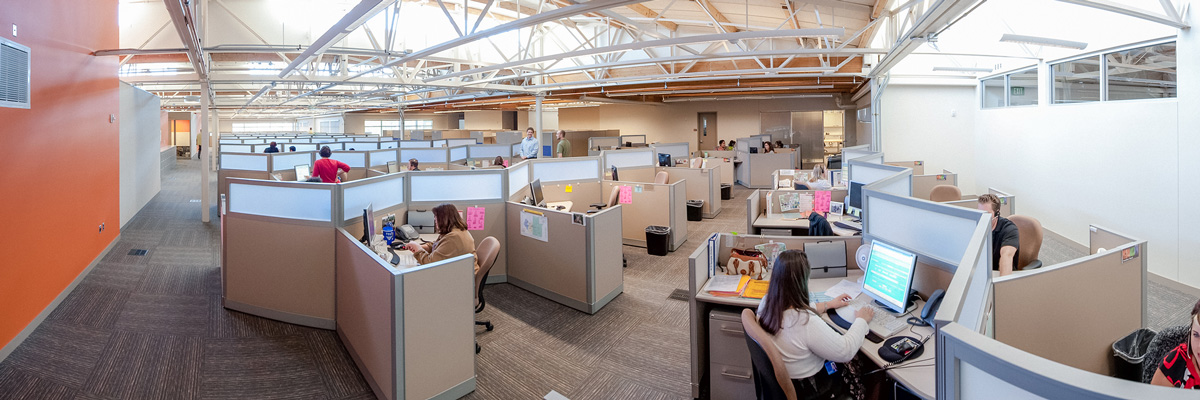
Process for moving overhead power lines underground
There are a variety of options for moving power lines underground. Learn about the processes and costs of relocating power lines.
On this page:
Three options for moving overhead power lines underground
With each option, you must comply with different and detailed required procedures. These include working with:
- SRP’s Distribution New Business.
- The Underground Conversion Service Area in accordance with Arizona Revised Statutes, Sections 40-341 through 40-356.
- The Improvement District for underground utility and cable television facilities in accordance with Arizona Revised Statutes, Section 48-620.
Option 1: Use SRP’s Distribution New Business
As an SRP residential customer, through SRP Distribution New Business, you may request that SRP convert your property’s overhead power lines to underground. You can initiate an inquiry by contacting SRP in either of the following ways:
Contact the SRP Distribution New Business at (602) 236-0777(602) 236-0777.
Submit a form online to start a new project.
A conversion through SRP Distribution New Business is a straightforward and relatively simple way to convert residential overhead electric facilities to underground.
An SRP representative will meet with you on-site at your property to review options. Shortly after that, SRP will provide a cost estimate and explain the breakdown of responsibilities – both SRP’s and the customer’s. You will have time to review and consider the information as well as ask questions.
Should you decide to proceed, you will enter into a contract with SRP for the work. The contract will require the customer to pay SRP upfront as a condition of SRP beginning the undergrounding project.
As with other options of conversion to underground, coordination is required with communication providers (internet and telephone) whose facilities may be on the overhead poles.
Option 2: Establish an Underground Conversion Service Area
Property owners can propose Underground Conversion Service Areas to relocate overhead power lines underground in their neighborhood in accordance with the statutory requirements and process provided in Arizona Revised Statutes, Sections 40-341 through 40-356.
Before moving forward, it's important that you and your neighbors carefully read these statutes to familiarize yourselves with the statutory process and requirements:
- 40-341 — Definitions
- 40-342 — Petitions of owners for cost study establishing an underground conversion service area
- 40-343 — Petition of owners and petition of public service corporation or public agency for establishment of underground conversion service area; notice of proposed lien
- 40-344 — Hearing on petition; notice
- 40-345 — Procedure for making and hearing protests and objections and withdrawing signatures
- 40-346 — Hearing on petition by corporation commission, board of supervisors or city or town council; determination of economic and technical feasibility; addition or elimination of certain areas
- 40-347 — Establishment of conversion costs; apportionment of costs; method of payment
- 40-348 — Conversion of service lines on owner's property; payment; notice of disconnection to owner
- 40-349 — Permit or easement for conversion of service lines to be furnished by owner
- 40-350 — Lien for cost of conversion; procedure to perfect lien; recording notice of lien; default; limitation of action to foreclose lien; disconnection of service upon default
- 40-351 — Sale of property to satisfy lien
- 40-352 — Relocation of underground facilities; public service corporation or public agency to be reimbursed for cost thereof
- 40-353 — Application of article; reinstallation of overhead facilities prohibited
- 40-354 — No extension of corporation commission jurisdiction to public agencies, video service networks or cable television systems
- 40-355 — Franchises, charters and ordinances of local governments not affected
- 40-356 — Nonseverability
Through an Underground Conversion Service Area, you and your neighbors can:
- Work together to assure that the underground service will be installed throughout your neighborhood.
- Proportionately share the cost of conversion according to the amount of land owned by each individual.
Underground Conversion Service Area costs vary and depend on several factors, including existing facilities. Individual costs are based on lot square footage (the larger the lot, the greater the cost).
To start the process, property owners must circulate and file with SRP, and with any telecommunication companies (telephone, cable TV, etc.) with overhead facilities, “first” petitions requesting that SRP and each telecommunications company conduct a study of the costs related to moving overhead power lines underground. |
Who is responsible for the petition?
You and your neighbors (fellow property owners) are responsible for completing the petition.
In most cases, one person is designated as the petition carrier – typically the first person to notify SRP about the proposed Underground Conversion Service Area. In all events, the initial petition must be signed and verified, under penalty of perjury, by a property owner within the proposed Underground Conversion Service Area.
Sign and send your petition
Here’s what you need to gather and send to SRP for review:
- The necessity for the proposed Underground Conversion Service Area.
- The promotion of convenience, necessity or welfare of the public.
- The name and address of the parcel owners within the proposed Underground Conversion Service Area as reflected on the records of the county assessor.
- Signatures of at least 60% of the property owners who hold at least 60% of the property square footage within the area. Include the signatures of both spouses when applicable.
- An accurate drawing of the proposed area, a list showing the square footage of each parcel or lot, and a list of all owners.
- The petition must be verified by one of the petitioners as to the information contained therein. For the SRP petition, the verification is made under penalty of perjury and must include a statement that the petition was presented to ALL property owners in the proposed conversion area, not just to those property owners in favor of SRP preparing a cost study.
When the property owners have compiled the required information meeting the statutory requirements, the petition carrier must verify, sign and date the bottom of each petition and send it to SRP for review at ugcsa@srpnet.com. |
SRP will prepare a cost estimate
SRP will then prepare a detailed study of the costs and put together detailed cost information for the project within 120 days. SRP’s cost study will include the total cost for SRP’s work and will include proportionate costs for each property owner. There is no charge for this cost study if the people in the area decide against the project.
What to expect once you receive an estimate
If you decide to move forward, you’ll need to provide SRP with a second petition requesting that SRP petition the Maricopa County Board of Supervisors to establish the proposed area as an Underground Conversion Service Area.
This second petition must be:
- Signed by at least 60% of the property owners who represent at least 60% of the land within the area.
- Signed by both spouses when applicable.
- Submitted within 90 days after you receive your cost estimates.
- The petition must be verified by one of the petitioners as to the information contained therein. For the SRP petition, the verification is made under penalty of perjury and must include a statement that the petition was presented to ALL property owners in the proposed conversion area, not just to those property owners in favor of SRP preparing a cost study.
When considering submission of a second petition, property owners should be aware that the Underground Conversion Service Area process is governed by the provisions of Arizona Revised Statutes, Sections 40-341 through 40-356.
In accordance with the statutes, should the Maricopa County Board of Supervisors ultimately issue an order establishing the proposed underground conversion service as an Underground Conversion Service Area, the costs incurred in placing the facilities underground shall be apportioned among the owners of property within the proposed Underground Conversion Service Area.
In that event, property owners will be required to pay the costs within 60 days of completion of the conversion from overhead to underground or shall pay over time on terms (including interest) set by the Board of Supervisors, with such payment to be secured by a lien on the parcel. Such lien shall attach to the property owner’s parcel and be superior in interest to all other liens (including the property owner’s home mortgage, if applicable) other than a tax lien. Each property owner should review their home mortgage obligations to ascertain whether it is a breach of their home mortgage obligations to allow the statutorily mandated superior lien to be recorded against their parcel. This may be a consideration of a property owner in deciding to sign a second petition.
Further, in accordance with the statutes, property owners within an established Underground Conversion Service Area may be required to provide easements to SRP to allow SRP facilities to be placed on their property. Failure to abide by the statutory requirements will subject the property to disconnection from electrical service.
Once SRP receives your second petition:
- SRP will petition the Maricopa County Board of Supervisors while telephone and cable TV companies will petition the Arizona Corporation Commission (ACC) for an order creating the Underground Conversion Service Area.
- The Board of Supervisors and ACC will hold hearings to determine whether the project is feasible and establish the terms of repaying the utilities.
If the controlling board and commission approve the Underground Conversion Service Area, they will direct the utilities to proceed with the conversion area.
Note, should the Board of Supervisors establish the proposed area as an Underground Conversion Service Area, the payment obligations and easement requirements are imposed by statute on each property, including the up to 40% of property owners not signing the second petition.
Start the petition processDownload the petition form to start the process. Download |
Option 3: Establish an Improvement District
Another statutory option is for property owners within a neighborhood to coordinate with the municipality in which their neighborhood is located to begin the process of the municipality establishing an “Improvement District” for the purpose of relocating overhead power lines underground in their neighborhood in accordance with the statutory requirements and process provided in Arizona Revised Statutes, Section 48-620.
Before moving forward, you and your neighbors should carefully read the statute to familiarize yourselves with the statutory process and requirements:
- The Title 48 Improvement District process bears several similarities to the Title 40 Underground Conversion Service Area process but has differences as well. You and your neighbors should carefully review the statutes and consider the approach that makes sense for your neighborhood.
- For the Title 48 Improvement District process, your neighborhood coordinates initially with your municipality.
- Similar to the Title 40 process, the Title 48 Improvement District process requires petitions from neighbors. For Title 48, those petitions are to the municipality and the municipality coordinates with SRP regarding the cost estimate, which the municipality will present to the neighbors for approval in official municipality proceedings.
- If the neighbors vote in favor of establishing the Title 48 Improvement District, the municipality contracts with SRP for the construction.
- Each property’s proportionate share of the costs is calculated similar to the Title 40 calculation method. Under Title 48, the municipality may elect to participate in payment of the costs, thus lowering each property’s proportionate share.
- Upon completion of the project, the Title 48 Improvement District process allows for the municipality to record liens against those properties paying their proportionate shares of the costs over time, rather than paying in full.
Relocating power lines: Start to finish
The process of moving overhead electrical lines underground is a challenging, complex effort that can take several months or, in some cases, over a year from start to finish.
Here is the typical series of the technical steps that SRP will perform to convert overhead to underground lines in the established Underground Conversion Service Area:
- Assess the area and design a new underground electrical distribution system.
- Determine conduit and equipment needed to replace the overhead system to ensure each property’s current service needs are met.
- Gather data for property lines, location of proposed trench routes and proposed electrical equipment in preparation for the easement acquisition process.
- SRP hires a civil contractor to install the primary conduit and oversees trenching/directional drilling and conduit installation work.
- NOTE: The property owners are responsible for the service trench, conduit and conduit installation.
- As conduit installation is completed, SRP Construction will begin to install underground conductors in the new conduit system, install new pad-mounted equipment and energize the underground electrical distribution system.
- When the underground system is completed and energized, the overhead facilities will be disconnected and removed from the jobsite.
- SRP’s civil contractor will complete all necessary restoration work during and after the completion of construction work.
Frequently asked questions
Find answers to some of the most typical questions about underground conversions.
This can vary depending on the average lot size and how the residential tract is laid out. The statute requires that the proposed area must be contiguous within a reasonably compact area of reasonable size.
No, there are too many variables involved that make it impossible to provide an off-the-cuff estimate.
No. The first petition is a request for SRP to prepare a joint summary of costs and the proportionate cost to each parcel for the property owners’ consideration in deciding whether to proceed with filing a second petition. Property owners will have plenty of time to review the cost figures the utilities submit for each parcel of property. The proposed conversion area will not go further unless at least 60% of the owners (representing at least 60% of the property within the area) indicate their approval by signing a second petition.
Customers can be sure their share of the conversion area costs will not exceed the estimates. If the actual costs are lower than the estimates, the savings will be passed on to the property owners. But if the costs run higher, the utilities are required by statute to absorb the difference. In certain circumstances, the statutes require that an individual parcel may be assessed the costs incurred by SRP should the property owner not place underground the electric service facilities beyond the point of delivery to the property’s service entrance. See A.R.S. Sections 40-348.A and 40-348.B.
Overhead lines that are providing service to the neighborhood would be removed. These overhead lines are also referred to as primary distribution lines. There may be areas where larger overhead lines or higher-voltage or transmission lines share a single pole or structure with primary distribution lines. In this case, the primary distribution line would be removed and placed underground, and the transmission lines would remain overhead. An option to also convert the transmission lines to underground exists which would require a cost study as requested specifically in the original petition.


